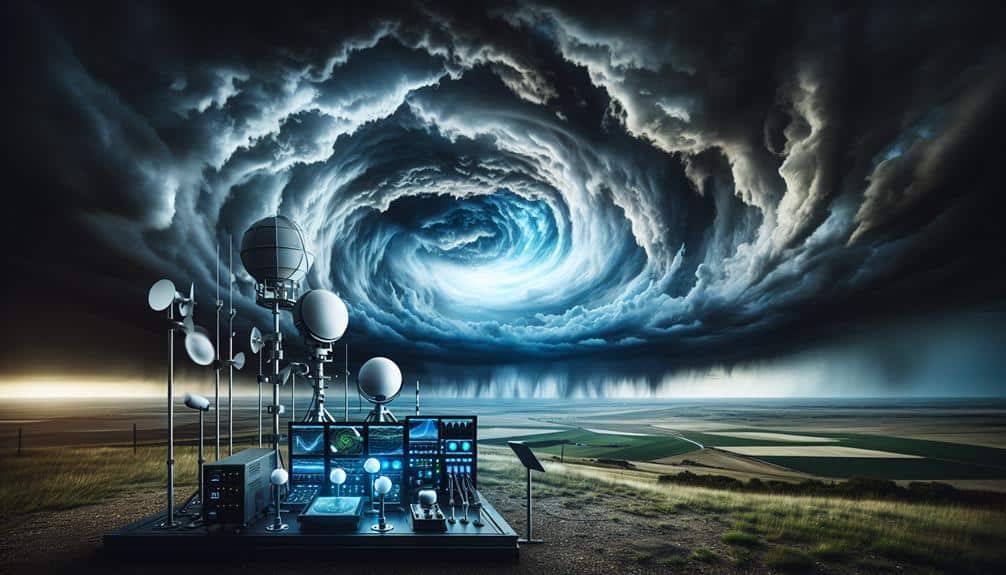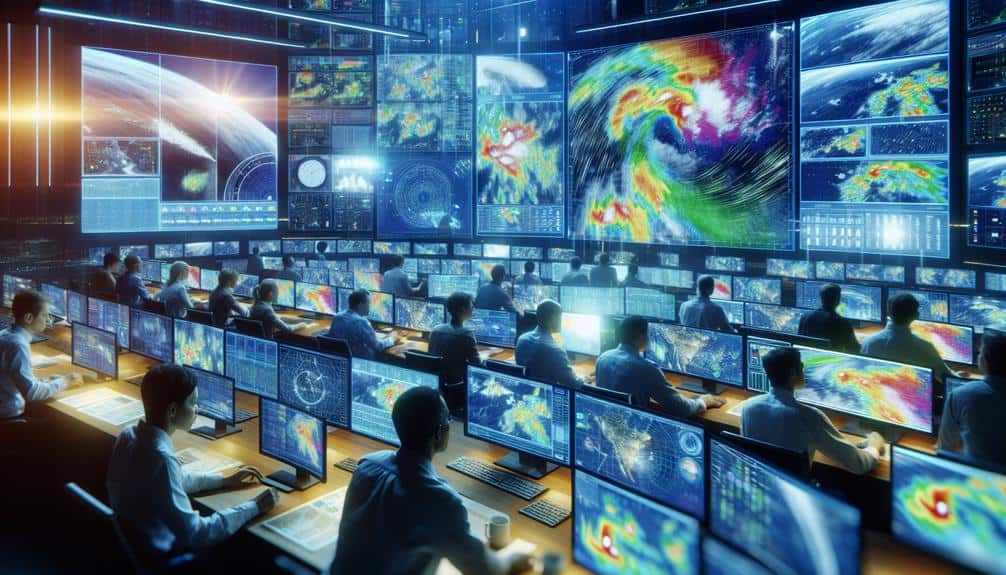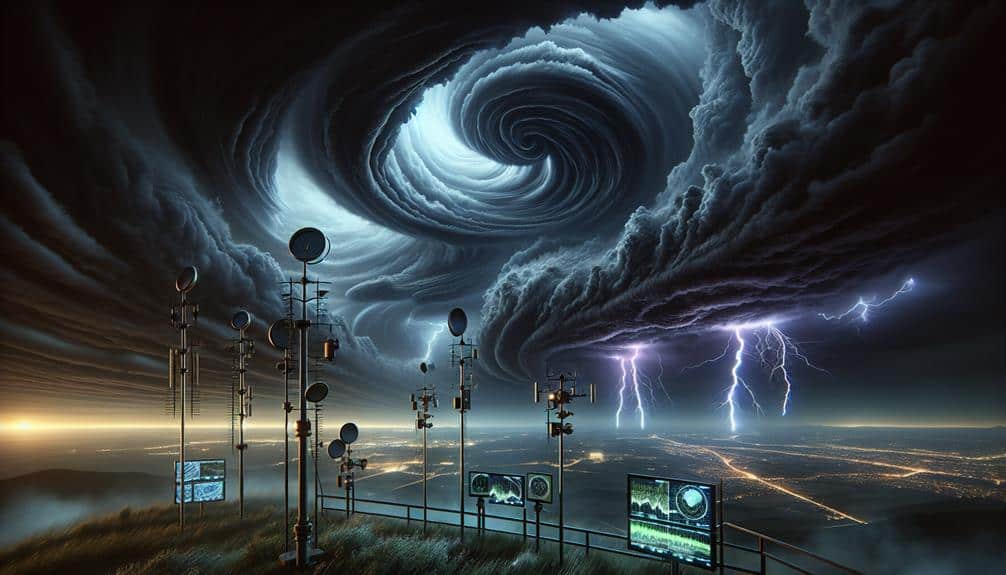We use seven advanced techniques for predicting tornado formations with high accuracy. By analyzing meteorological data, Doppler radar velocity profiles, and real-time satellite imagery, we get critical insights into storm dynamics. Atmospheric pressure monitoring helps us catch early warning signs, while wind shear measurements pinpoint tornado-prone conditions. Computer model simulations using diverse datasets, including past event analysis, refine our predictions. Ground-based observations from weather stations and advanced sensors provide the final layer of real-time data. These methods combined boost our tornado prediction capabilities substantially, and there's more to explore about how each technique contributes.
Key Points
- Meteorological Data Analysis: Advanced machine learning algorithms and statistical forecasting methods interpret atmospheric parameters to predict tornado formations.
- Doppler Radar Utilization: Analyzes velocity and precipitation patterns to detect tornado-prone conditions.
- Satellite Imagery Interpretation: Real-time data from geostationary satellites monitors atmospheric conditions and storm development.
- Wind Shear Measurement: Quantifies changes in wind speed and direction at different altitudes, identifying environments conducive to tornado formation.
Meteorological Data Analysis
In meteorological data analysis, we focus on interpreting various atmospheric parameters, such as temperature, humidity, wind speed, and pressure, to predict tornado formations accurately. By leveraging statistical forecasting methods and advanced machine learning algorithms, we can analyze these parameters to identify potential tornado genesis.
Firstly, statistical forecasting involves constructing models based on historical trend analysis, which helps us understand patterns and anomalies in tornado occurrences. By examining past data, we can detect correlations between specific atmospheric conditions and tornado formations. This approach allows us to quantify the likelihood of tornado events under similar future conditions.
Incorporating machine learning algorithms enhances our predictive accuracy. These algorithms can handle vast datasets and identify intricate, non-linear relationships between variables that traditional statistical methods might miss. By training these algorithms on historical weather data, we can enhance our ability to forecast tornadoes with greater precision.
Additionally, we must consider the impact of climate change on tornado patterns. Shifts in global temperature and atmospheric dynamics alter the frequency and intensity of tornadoes. By integrating climate change impact into our models, we guarantee our predictions remain relevant and adaptive.
Through robust meteorological data analysis, we can empower ourselves with the knowledge needed to anticipate and respond to tornado threats effectively.
Doppler Radar Utilization
Let's explore how Doppler radar helps us predict tornado formations by analyzing velocity data and detecting precipitation patterns.
By measuring the velocity of particles within a storm, we can identify rotation indicative of potential tornadoes.
Additionally, advanced precipitation detection methods enable us to distinguish between rain, hail, and debris, providing critical insights for early warnings.
Velocity Data Analysis
We frequently rely on Doppler radar to analyze velocity data, as it provides critical real-time insights into wind patterns and rotational movements within severe storm systems. This technology allows us to detect minute changes in the velocity of particles within a storm, facilitating accurate storm tracking and early identification of potential tornado formations.
By examining the velocity data, we can observe the radial velocities, which help us discern rotational signatures indicative of mesocyclones. Mesocyclones, with their distinct cyclonic rotation, are often precursors to tornadoes. The Doppler radar's capability to measure the speed and direction of wind—both towards and away from the radar—enables us to map out these intricate wind patterns.
Moreover, the data-driven analysis of Doppler velocity fields aids in identifying areas of convergence and divergence within a storm system. Patterns of convergence can denote updrafts, while divergence may highlight downdrafts, both critical in understanding storm dynamics. The precise interpretation of these velocity signatures empowers us to issue timely and accurate warnings, thereby providing individuals with the freedom to take necessary precautions.
In essence, leveraging Doppler radar for velocity data analysis is indispensable for enhancing our tornado prediction capabilities and ensuring public safety.
Precipitation Detection Methods
Building upon our understanding of velocity data analysis, we now turn to the utilization of Doppler radar for detecting precipitation, a key element in predicting tornado formations. Doppler radar provides us with real-time data on precipitation intensity, distribution, and movement, which are vital for accurate storm tracking.
By analyzing the radar's reflectivity data, we can identify areas of heavy rainfall that may indicate the presence of supercell thunderstorms, a precursor to tornado development.
Furthermore, Doppler radar also assists in lightning detection. By correlating radar data with lightning strikes, we can refine our storm tracking capabilities. Lightning activity often increases in the mature phases of a storm, which can signal an increased likelihood of tornadic activity. This combined approach enhances our ability to forecast severe weather events with a higher level of precision.
Moreover, Doppler radar's dual-polarization technology allows us to distinguish between different types of precipitation, such as rain, hail, and snow. This differentiation is essential for understanding storm dynamics and potential tornado formation.
With these advanced techniques, we not only gain a clearer picture of current weather conditions but also empower ourselves to take informed actions, ensuring safety and preparedness.
Satellite Imagery Interpretation

Interpreting satellite imagery is vital for predicting tornado formations, as it provides real-time data on atmospheric conditions and storm development. By analyzing cloud patterns and storm tracking, we can identify the early signs of severe weather systems.
High-resolution satellite images allow us to observe the structure and evolution of thunderstorms, including the presence of supercells, which are often precursors to tornadoes.
In weather forecasting, satellite data is indispensable for storm prediction. We use geostationary satellites to continuously monitor large areas, capturing detailed visual and infrared images. These images help us detect temperature changes, moisture levels, and cloud dynamics. For instance, identifying overshooting tops in cumulonimbus clouds can indicate strong updrafts, a pivotal factor in tornado genesis.
Moreover, satellite imagery plays a significant role in validating and refining numerical weather models. By comparing real-time satellite data with model outputs, we can improve the accuracy of our predictions. This iterative process enhances our ability to forecast severe weather events and issue timely warnings, ultimately safeguarding lives and property.
Atmospheric Pressure Monitoring
In addition to satellite imagery, monitoring atmospheric pressure is a critical technique for predicting tornado formations, as it provides insights into the dynamics of storm systems and potential areas of severe weather development.
By analyzing barometric pressure data, we can identify pressure drops that indicate the presence of a developing storm system. These pressure troughs often precede tornado formation and can act as early warning indicators.
Accurate pressure readings are crucial for emergency response and public safety. When we detect significant pressure changes, we can issue timely alerts, allowing communities to take appropriate protective measures.
Advances in technology, such as high-resolution barometers and automated weather stations, enable us to gather precise data across vast geographical areas. This data can then be integrated into predictive models to enhance our understanding of storm behavior.
We must also consider the role of atmospheric pressure in the broader context of meteorological phenomena. Low-pressure systems, for instance, are frequently linked with severe thunderstorms, which can give rise to tornadoes. By continuously monitoring these systems, we can enhance our predictive accuracy and better prepare for emergency scenarios.
Ultimately, our goal is to leverage atmospheric pressure monitoring to enhance public safety and guarantee effective emergency response.
Wind Shear Measurement

Let's focus on wind shear measurement, a critical factor in tornado prediction.
We utilize tools like Doppler radar and anemometers to quantify wind speed and direction at various altitudes.
Importance of Wind Shear
How exactly can we measure wind shear to predict tornado formations with greater accuracy? To address this, we need a solid understanding of wind shear dynamics and its impact on tornado risk. Wind shear refers to the variation in wind speed and direction at different altitudes. By analyzing these variations, we can greatly improve our forecasting precision.
Wind shear is an essential parameter in tornado genesis. When wind changes speed and direction rapidly over a short vertical distance, it creates an environment conducive to the formation of rotating updrafts, or mesocyclones, which are precursors to tornadoes. As a result, quantifying wind shear dynamics is crucial for predicting tornado risk.
We measure wind shear by examining both horizontal and vertical components. Vertical wind shear, which involves changes in wind speed and direction with height, and horizontal wind shear, which involves variations across a geographical area, both provide vital data. By analyzing these components, we can identify atmospheric conditions that elevate tornado risk and improve our predictive models.
Understanding wind shear's impact allows us to better anticipate the development of severe weather events, hence enhancing our preparedness and response strategies. Through precise measurement and analysis, we can mitigate the devastating effects of tornadoes on communities.
Tools for Measurement
When predicting tornado formations, we rely on advanced tools like Doppler radar, weather balloons, and wind profilers to measure wind shear accurately. Doppler radar is indispensable for its ability to detect rotational patterns and velocity within storm systems. By emitting radio waves and analyzing their return, we can visualize wind speed and direction at various altitudes. This data is essential for identifying mesocyclones, the precursors to tornadoes.
Weather balloon tracking provides vertical profiles of the atmosphere. These balloons, equipped with radiosondes, ascend through the troposphere, collecting data on temperature, humidity, pressure, and wind speed at different heights. By analyzing this information, we can assess the vertical wind shear, which is a vital indicator of severe weather potential.
Wind profilers, another fundamental tool, utilize remote sensing technologies to measure wind speed and direction continuously at multiple levels above the ground. These instruments emit radio waves vertically and interpret the returned signals to provide real-time wind profiles. This continuous data stream helps us monitor changes in wind shear, offering valuable insights into storm development.
Data Interpretation Techniques
Interpreting wind shear measurements involves analyzing data from multiple sources to identify patterns indicative of potential tornado formation. We're not just looking at raw data; we leverage advanced techniques like machine learning algorithms to sift through vast datasets efficiently. These algorithms help us pinpoint vital changes in wind speed and direction that often precede tornado formation.
Incorporating historical trends is essential. By examining past tornado events, we can identify recurring wind shear patterns that signal high-risk scenarios. This historical perspective enhances our predictive models, enabling us to make more accurate forecasts. We gather wind shear data from ground-based sensors, weather balloons, and even Doppler radar, ensuring a thorough dataset.
Once we collect the data, the real work begins. We utilize machine learning algorithms to analyze the intricate relationships between wind shear variables and tornado occurrences. These algorithms can process massive amounts of data rapidly, identifying subtle patterns that human analysts might miss. This computational power gives us a significant advantage in predicting tornado formations.
Computer Model Simulations
Utilizing advanced computer model simulations, we can accurately predict tornado formations by analyzing atmospheric data in real-time. Simulation accuracy has greatly improved thanks to recent technological advancements. High-resolution models allow us to simulate the intricate interactions between temperature, humidity, and wind patterns that contribute to tornado genesis. These models integrate vast amounts of data, including satellite imagery and atmospheric soundings, to provide a holistic view of potential tornado conditions.
Real-time tracking is essential for timely predictions and public safety. Modern algorithms leverage machine learning to enhance real-time tracking, offering more precise and quicker updates. Algorithm improvements enable these models to adapt to new data rapidly, refining their predictions as conditions evolve. This dynamic adjustment is crucial for issuing accurate warnings and minimizing false alarms, thereby offering more freedom to communities by reducing unnecessary disruptions.
We feed our simulations with diverse datasets, ranging from Doppler radar readings to numerical weather prediction outputs. Such comprehensive data usage ensures that our simulations remain strong and reliable.
Ground-Based Observations

Ground-based observations provide necessary, real-time data that complement computer model simulations for predicting tornado formations. By deploying a network of weather stations, we gather vital metrics like temperature, humidity, wind speed, and barometric pressure. These parameters offer detailed insights that models alone can't achieve.
Soil moisture levels have a significant impact on the atmospheric conditions conducive to tornado genesis. For instance, high soil moisture can increase the humidity in the lower atmosphere, promoting instability. We use soil moisture sensors to monitor these levels and feed this data into our predictive models, enhancing their accuracy.
Topography analysis is another essential component of ground-based observations. The physical landscape—hills, valleys, and plains—affects wind patterns and storm development. Using LIDAR and GPS technologies, we conduct detailed topography analyses to understand how terrain influences tornado paths. This helps us pinpoint potential hotspots for tornado activity.
Frequently Asked Questions
How Can Predictive Techniques Be Communicated Effectively to the Public?
We can enhance public education on predictive techniques through clear communication strategies. Leveraging data-driven insights and scientific terminology guarantees accuracy, empowering the public with knowledge, thereby fostering informed decision-making and bolstering their sense of freedom.
What Role Do Human Spotters Play in Tornado Prediction?
Human spotters' accuracy greatly enhances tornado prediction through real-time communication. They provide immediate, ground-level data that complements radar, increasing overall prediction reliability and allowing us to take timely action, ensuring our safety and freedom.
How Does Climate Change Impact Tornado Formation Predictions?
Climate change affects tornado patterns by altering atmospheric conditions. We need to analyze shifting temperature gradients, humidity levels, and wind shear to improve predictions. Our models must adapt to these evolving variables for accurate forecasting.
What Are the Ethical Considerations in Tornado Prediction Technology?
Guiding ethical dilemmas in tornado prediction technology is like steering through a storm; it's essential to balance data privacy with public safety. We must guarantee technological advancements don't infringe on individual freedoms while maximizing timely, accurate warnings.
Are There Any Limitations to Current Tornado Prediction Technologies?
We face significant forecasting challenges due to data accuracy issues and technological limitations. Despite advancements, predictive shortcomings remain, making it difficult to achieve precise tornado predictions. These limitations underscore the need for continued innovation and data enhancement.


